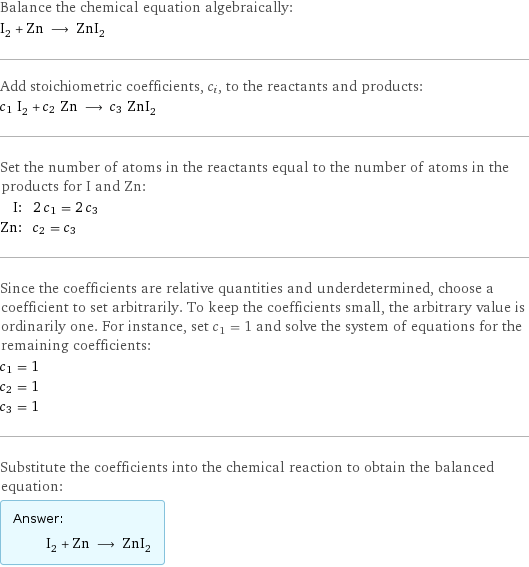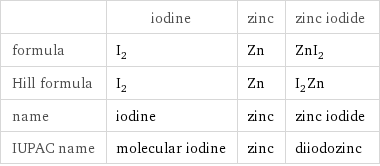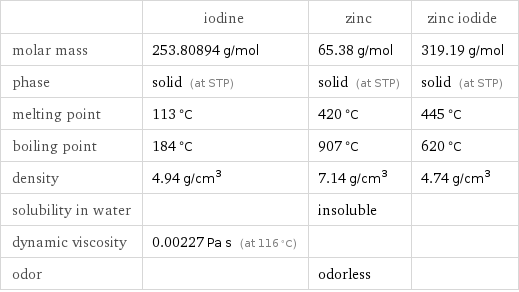Input interpretation

I_2 iodine + Zn zinc ⟶ ZnI_2 zinc iodide
Balanced equation

Balance the chemical equation algebraically: I_2 + Zn ⟶ ZnI_2 Add stoichiometric coefficients, c_i, to the reactants and products: c_1 I_2 + c_2 Zn ⟶ c_3 ZnI_2 Set the number of atoms in the reactants equal to the number of atoms in the products for I and Zn: I: | 2 c_1 = 2 c_3 Zn: | c_2 = c_3 Since the coefficients are relative quantities and underdetermined, choose a coefficient to set arbitrarily. To keep the coefficients small, the arbitrary value is ordinarily one. For instance, set c_1 = 1 and solve the system of equations for the remaining coefficients: c_1 = 1 c_2 = 1 c_3 = 1 Substitute the coefficients into the chemical reaction to obtain the balanced equation: Answer: | | I_2 + Zn ⟶ ZnI_2
Structures

+ ⟶
Names

iodine + zinc ⟶ zinc iodide
Reaction thermodynamics
Enthalpy

| iodine | zinc | zinc iodide molecular enthalpy | 0 kJ/mol | 0 kJ/mol | -208 kJ/mol total enthalpy | 0 kJ/mol | 0 kJ/mol | -208 kJ/mol | H_initial = 0 kJ/mol | | H_final = -208 kJ/mol ΔH_rxn^0 | -208 kJ/mol - 0 kJ/mol = -208 kJ/mol (exothermic) | |
Equilibrium constant
![Construct the equilibrium constant, K, expression for: I_2 + Zn ⟶ ZnI_2 Plan: • Balance the chemical equation. • Determine the stoichiometric numbers. • Assemble the activity expression for each chemical species. • Use the activity expressions to build the equilibrium constant expression. Write the balanced chemical equation: I_2 + Zn ⟶ ZnI_2 Assign stoichiometric numbers, ν_i, using the stoichiometric coefficients, c_i, from the balanced chemical equation in the following manner: ν_i = -c_i for reactants and ν_i = c_i for products: chemical species | c_i | ν_i I_2 | 1 | -1 Zn | 1 | -1 ZnI_2 | 1 | 1 Assemble the activity expressions accounting for the state of matter and ν_i: chemical species | c_i | ν_i | activity expression I_2 | 1 | -1 | ([I2])^(-1) Zn | 1 | -1 | ([Zn])^(-1) ZnI_2 | 1 | 1 | [ZnI2] The equilibrium constant symbol in the concentration basis is: K_c Mulitply the activity expressions to arrive at the K_c expression: Answer: | | K_c = ([I2])^(-1) ([Zn])^(-1) [ZnI2] = ([ZnI2])/([I2] [Zn])](../image_source/9a815fd98a9a9c27d6a7fdbbc03a2ede.png)
Construct the equilibrium constant, K, expression for: I_2 + Zn ⟶ ZnI_2 Plan: • Balance the chemical equation. • Determine the stoichiometric numbers. • Assemble the activity expression for each chemical species. • Use the activity expressions to build the equilibrium constant expression. Write the balanced chemical equation: I_2 + Zn ⟶ ZnI_2 Assign stoichiometric numbers, ν_i, using the stoichiometric coefficients, c_i, from the balanced chemical equation in the following manner: ν_i = -c_i for reactants and ν_i = c_i for products: chemical species | c_i | ν_i I_2 | 1 | -1 Zn | 1 | -1 ZnI_2 | 1 | 1 Assemble the activity expressions accounting for the state of matter and ν_i: chemical species | c_i | ν_i | activity expression I_2 | 1 | -1 | ([I2])^(-1) Zn | 1 | -1 | ([Zn])^(-1) ZnI_2 | 1 | 1 | [ZnI2] The equilibrium constant symbol in the concentration basis is: K_c Mulitply the activity expressions to arrive at the K_c expression: Answer: | | K_c = ([I2])^(-1) ([Zn])^(-1) [ZnI2] = ([ZnI2])/([I2] [Zn])
Rate of reaction
![Construct the rate of reaction expression for: I_2 + Zn ⟶ ZnI_2 Plan: • Balance the chemical equation. • Determine the stoichiometric numbers. • Assemble the rate term for each chemical species. • Write the rate of reaction expression. Write the balanced chemical equation: I_2 + Zn ⟶ ZnI_2 Assign stoichiometric numbers, ν_i, using the stoichiometric coefficients, c_i, from the balanced chemical equation in the following manner: ν_i = -c_i for reactants and ν_i = c_i for products: chemical species | c_i | ν_i I_2 | 1 | -1 Zn | 1 | -1 ZnI_2 | 1 | 1 The rate term for each chemical species, B_i, is 1/ν_i(Δ[B_i])/(Δt) where [B_i] is the amount concentration and t is time: chemical species | c_i | ν_i | rate term I_2 | 1 | -1 | -(Δ[I2])/(Δt) Zn | 1 | -1 | -(Δ[Zn])/(Δt) ZnI_2 | 1 | 1 | (Δ[ZnI2])/(Δt) (for infinitesimal rate of change, replace Δ with d) Set the rate terms equal to each other to arrive at the rate expression: Answer: | | rate = -(Δ[I2])/(Δt) = -(Δ[Zn])/(Δt) = (Δ[ZnI2])/(Δt) (assuming constant volume and no accumulation of intermediates or side products)](../image_source/02ac86daa783569455fb46756a60c3ce.png)
Construct the rate of reaction expression for: I_2 + Zn ⟶ ZnI_2 Plan: • Balance the chemical equation. • Determine the stoichiometric numbers. • Assemble the rate term for each chemical species. • Write the rate of reaction expression. Write the balanced chemical equation: I_2 + Zn ⟶ ZnI_2 Assign stoichiometric numbers, ν_i, using the stoichiometric coefficients, c_i, from the balanced chemical equation in the following manner: ν_i = -c_i for reactants and ν_i = c_i for products: chemical species | c_i | ν_i I_2 | 1 | -1 Zn | 1 | -1 ZnI_2 | 1 | 1 The rate term for each chemical species, B_i, is 1/ν_i(Δ[B_i])/(Δt) where [B_i] is the amount concentration and t is time: chemical species | c_i | ν_i | rate term I_2 | 1 | -1 | -(Δ[I2])/(Δt) Zn | 1 | -1 | -(Δ[Zn])/(Δt) ZnI_2 | 1 | 1 | (Δ[ZnI2])/(Δt) (for infinitesimal rate of change, replace Δ with d) Set the rate terms equal to each other to arrive at the rate expression: Answer: | | rate = -(Δ[I2])/(Δt) = -(Δ[Zn])/(Δt) = (Δ[ZnI2])/(Δt) (assuming constant volume and no accumulation of intermediates or side products)
Chemical names and formulas

| iodine | zinc | zinc iodide formula | I_2 | Zn | ZnI_2 Hill formula | I_2 | Zn | I_2Zn name | iodine | zinc | zinc iodide IUPAC name | molecular iodine | zinc | diiodozinc
Substance properties

| iodine | zinc | zinc iodide molar mass | 253.80894 g/mol | 65.38 g/mol | 319.19 g/mol phase | solid (at STP) | solid (at STP) | solid (at STP) melting point | 113 °C | 420 °C | 445 °C boiling point | 184 °C | 907 °C | 620 °C density | 4.94 g/cm^3 | 7.14 g/cm^3 | 4.74 g/cm^3 solubility in water | | insoluble | dynamic viscosity | 0.00227 Pa s (at 116 °C) | | odor | | odorless |
Units
